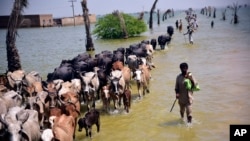The United Nations said Thursday the recent catastrophic floods in Pakistan have destroyed or damaged nearly 27,000 schools, preventing more than 2 million children in the country from returning to their education.
UNICEF said Thursday that more than two months after the devastating floods engulfed large areas of Pakistan, the tops of school buildings are just becoming visible in some calamity-hit districts and it could take months before the flood waters completely recede.
“Almost overnight, millions of Pakistan’s children lost family members, homes, safety, and their education, under the most traumatic circumstances,” said Robert Jenkins, UNICEF’s global director of education, after visiting flood-ravaged areas.
“Now, faced with the uncertainty of when they’ll be able to return to school, and having already endured some of the world’s longest school closures due to the pandemic, they are experiencing yet another threat to their future,” Jenkins warned.
The deluge, triggered by climate change-driven torrential monsoon seasonal rains, has affected 33 million people and killed more than 1,700 others across the country. Flood waters washed away at least 800,000 houses, killed 1.2 million crucial livestock animals and drenched 9.4 million acres of crop area, according to Pakistani and U.N. officials.
UNICEF estimates more than 3.5 million childrens’ education has been interrupted due to floods all over Pakistan. It warns that the longer schools remain closed, the greater the risk of children dropping out of altogether, increasing their likelihood of being forced into child labor and exposure to other forms of abuse in the impoverished South Asian nation of about 220 million people.
Pakistan already has the world’s second-highest number of out-of-school children with an estimated 22.8 million children aged 5 to 16 not attending school, representing 44% of the total population in that age group, according to UNICEF.
Many of the districts hit the worst by the flooding were already listed among Pakistan's most vulnerable areas, where a third of boys and girls were already out of school, and 50% of children suffered from stunting.
The U.N. agency noted Thursday that during the height of the coronavirus pandemic, schools across Pakistan were fully or partially closed for 64 weeks until they were reopened in March — some of the world’s longest school closures.
“Less than six months on, the destruction caused by the extreme floods means schoolchildren are once again locked out of learning. Excessive damage to infrastructure including electricity and internet connectivity has left remote learning largely inaccessible,” UNICEF said.
UNICEF says it has established more than 500 temporary learning centers in the worst-affected Pakistani districts, and supported teachers and children with education supplies.
“For some children, who had never been enrolled in school before, these learning centers are their very first experience of education. We need to do all that we can to ensure they continue learning when they return to their homes,” Jenkins said.
Several districts of the hardest-hit southern Sindh province have remained underwater for nearly two months.
In its latest flood review report, the U.N. has warned that winter is fast approaching and flood victims urgently need adequate shelter, as well as nonfood items, such as tents and blankets.
The report says public health concerns are high due to damaged infrastructure, the outbreak of waterborne diseases, stagnating water and inadequate sanitation facilities. The practice of open defecation has increased from one-fifth before the floods to over one-third of the affected population, with 6 million no longer having home sanitation facilities, the U.N. said.









